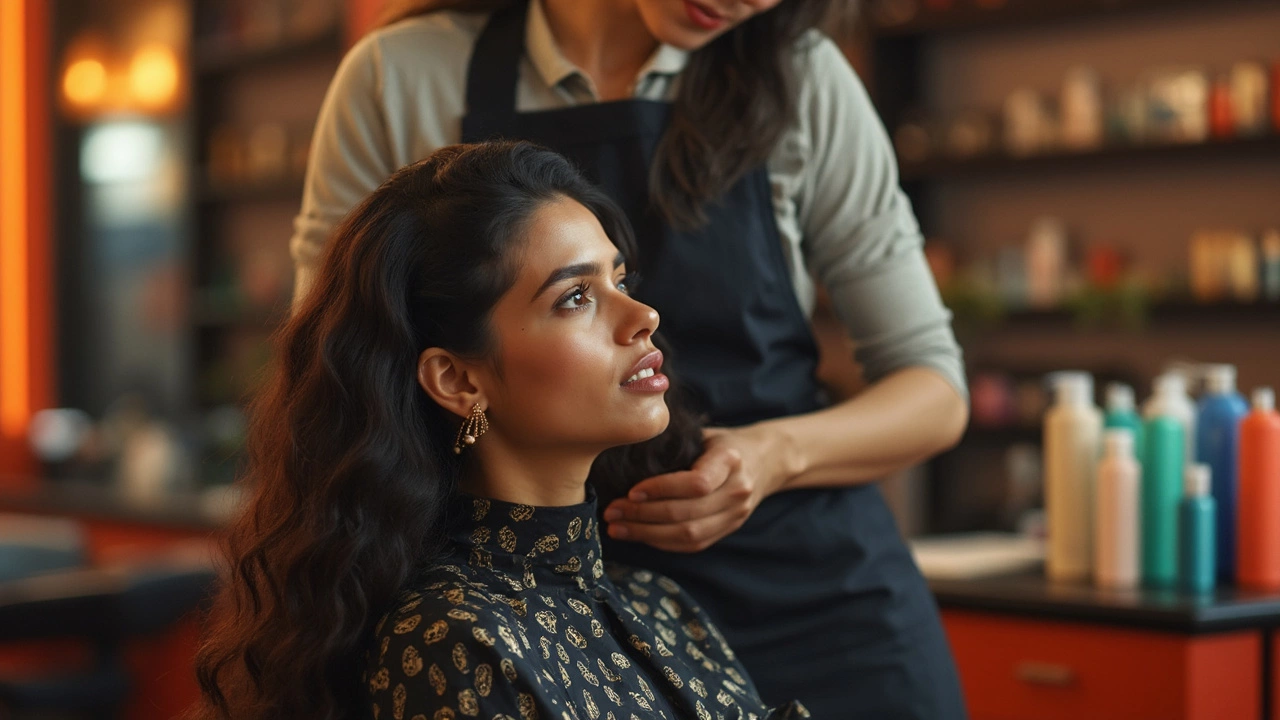
You know that amazing moment when your hairdresser spins you around and your hair looks so shiny and smooth? Yep, they’re not just using magic—there’s a real recipe behind that silkiness. Most of the time, it’s a mix of the right products, some clever techniques, and a good bit of know-how. It’s not as mysterious as people think, but it’s definitely not just regular shampoo and conditioner either.
Hairdressers have a go-to line up: deep conditioning masks, leave-in creams, smoothing serums, and sometimes a shot of lightweight oil. The real MVPs are silicone-based serums—they coat your strands, cut down frizz, and make everything feel like silk. But it’s not just what’s on your hair; it’s also how they apply it. Ever notice how they work the product though every strand, never skipping ends? Turns out, technique matters just as much as the product itself.
Some salons even have gloss treatments—think of them as temporary topcoats for your hair. These are quick to apply and give an instant shine, but don’t expect them to last longer than a few washes. And while those smells are lovely, don’t get distracted: It’s the ingredients like argan oil, keratin, and panthenol doing the real heavy lifting. Good news? Plenty of affordable brands sneak those same magic-makers into their own formulas, so you don’t need fancy salon bottles at home to get started.
- Salon Secrets: What Makes Hair Silky?
- Ingredients That Actually Work
- Pro Techniques vs. DIY at Home
- Keeping That Silky Look Longer
Salon Secrets: What Makes Hair Silky?
When you sit in that salon chair, your hairdresser is working with a playbook the rest of us rarely see. Making hair absolutely silky isn’t luck—it’s a science mixed with a bit of craft. The secret weapon is all about smoothing the hair cuticle so light bounces right off, making it look super healthy and touchable.
So, what are the exact moves? First, most salons do a double wash: they shampoo once to clean out dirt and oil, then do a second round to really prep your hair for what comes next. This double cleanse means whatever comes after (like conditioner or treatments) can get deep into the strands.
- Hair silky products: These usually have special silicones or lightweight oils that coat the hair—making it feel like glass, but never greasy.
- Deep conditioning: Hairdressers use rich masks that contain ingredients like keratin, panthenol, or argan oil. These help fill in tiny gaps in your hair's surface and lock down the cuticle.
- Serums and sprays: After rinsing, while your hair is still damp, stylists run a serum or smoothing spray through your hair. Think of this as sealing the deal—these products act like tiny shields against frizz and dullness.
- Cold water rinse: You may notice some pros finish with a splash of cool water. It’s not just a fancy trick—it actually helps flatten the hair cuticle for even more shine.
Technique matters, too. Hairdressers always distribute product evenly using a wide-tooth comb or their fingers, focusing on the ends (where dryness and damage really show up). When it’s time to blow dry, most pros use a round brush and point the dryer nozzle down the hair shaft. This simple move keeps the cuticle closed and smooth, which is key for that just-left-the-salon finish.
Here’s something you might not know: sometimes it’s about what they don’t use. Most salons avoid cheap, harsh shampoos full of sulfates and alcohol. These can strip away shine faster than you can say bad hair day. The focus is always on keeping hair hydrated and protected every step of the way.
Ingredients That Actually Work
If you’ve ever wondered why salon products leave your hair looking so good, it’s really about the ingredients. Some stuff actually works—and you can spot it right on the label if you know what to look for.
Let’s start with silicones. Names like dimethicone and cyclopentasiloxane sound technical, but all you need to know is they smooth your hair’s surface. Silicones do a killer job at making your hair less frizzy, super shiny, and—yep—silky. But if you use them all the time without clarifying, they can build up, so make sure to wash with a clarifying shampoo once in a while to keep things fresh.
Another hero ingredient: oils. Argan oil is huge in the hair world because it’s lightweight and doesn’t weigh your hair down. Coconut oil is another favorite, especially for super dry or curly hair, but it can be a bit heavy on fine strands. You’ll also see jojoba and avocado oil pop up—these help hydrate and soften, locking in moisture so your hair stays bouncy, not greasy.
Don’t skip over proteins like keratin and silk amino acids. When you see these listed, know they’re helping patch up damaged areas and boost strength. So if your hair feels rough or fried from heat tools, look for these on your next product run. Panthenol (also called provitamin B5) is another all-star—this one helps your hair grab on to moisture, making it look thicker and feel smoother.
Here’s a quick cheat sheet of ingredients that actually help with hair silky results:
- Silicones (Dimethicone, Cyclopentasiloxane): Add slip, shine, and smoothness.
- Argan oil: Lightweight, brings shine, protects from heat.
- Coconut oil: Deep hydration, great for dry or curly hair.
- Keratin: Strengthens hair, fills in weak spots.
- Panthenol: Attracts and seals in moisture.
If you’re shopping on a budget, don’t worry—plenty of drugstore brands use these same powerhouse ingredients. You don’t need to spend a fortune to get silky hair at home if you know what to look for.

Pro Techniques vs. DIY at Home
So, what do the pros know that most of us don’t? First, it’s all about layering products the right way and using heat tools strategically. In salons, hairdressers usually apply leave-in treatments and smoothing serums to damp hair, comb everything through (no shortcuts here), and then get to work with a round brush and dryer. The movement and tension created while blow-drying are key—this is what gets each strand super smooth and polished.
One thing hairdressers are obsessed with: not overloading hair with product. The trick is even, light layers—focus on mids and ends, not the roots. Professional blowouts can use higher-end serums and thermal protection sprays, but it’s the technique that makes the real difference. The brush makes your hair lie flat and shiny while the heat seals the cuticle. Plus, they really don’t rush this step. According to a survey by Modern Salon magazine in 2024, 76% of stylists say blow-drying with proper brush technique is the most important step for hair silky finishes.
You can totally borrow these moves at home. Here’s what actually works:
- Start with a microfiber towel to get rid of excess water (less frizz later).
- Apply a bit of smoothing serum or leave-in conditioner while it’s still damp.
- Section your hair—it helps with even styling and prevents heat damage.
- Use a round brush and work in small sections while blow-drying, aiming downward.
- For extra gloss, finish with a quick blast of cool air to help lock the cuticle down.
Here’s a quick comparison of typical salon vs. DIY tools and techniques:
| Technique/Tool | Salon Method | At-Home Approach |
|---|---|---|
| Products used | Professional serums, glosses, heat sprays | Drugstore serums, leave-in conditioners |
| Tools | Pro dryer, ceramic brushes, flat iron (optional) | Standard dryer, round brush, basic straightener |
| Technique | Section by section, high tension, slow drying | Sectioned (if patient), medium tension, sometimes rushed |
| Duration | 30–45 minutes (depending on length) | 15–30 minutes (usually shorter at home) |
Here’s a tip from stylist Sam Villa, Artistic Director at Redken:
“Don’t blast hair with heat all at once. Take your time, work in small pieces, and let each section cool before moving on. That’s what keeps hair looking salon-level shiny.”
Don’t feel like you’re missing out if you don’t have pro products—your own technique matters just as much. Small changes, like sectioning and slowing down your blow-dry, will make a bigger difference than you think.
Keeping That Silky Look Longer
So you’ve finally got that salon-fresh silkiness, but keeping it past the first wash can feel like chasing a unicorn. The biggest secret? Consistency with the right products and keeping heat and harsh chemicals in check. Water temperature matters too—hot water strips out all the good stuff your hairdresser just put in. Cool it down to help lock in shine and moisture.
If you want to hang onto that hair silky finish, make leave-in conditioner your new best friend. It smooths your hair, reduces frizz, and helps protect against the daily stuff that makes hair dry and dull. Another practical tip: avoid washing every day. Over-washing actually pulls out natural oils and causes dryness, so aim for two to three times a week, unless your hair gets oily fast.
- Use silk or satin pillowcases—cotton roughs up the hair cuticle while silk helps keep things smooth.
- Apply a few drops of lightweight oil (think argan or jojoba) on the mid-lengths and ends before styling or after drying. Don’t go near the roots unless you want greasy vibes.
- Always use a heat protectant spray before grabbing that straightener or curling iron. Pretty much every stylist swears by this for keeping hair healthy and glossy.
- Detangle gently. Grab a wide-tooth comb or a detangling brush, especially when your hair is wet. Yanking causes breakage and kills that silky look fast.
If you color or bleach your hair, it's even more important to do a weekly deep conditioning treatment. There are inexpensive masks you can leave on while you watch your favorite show. Professional stylists often mention Olaplex No. 3, but even drugstore options with keratin or coconut oil give real results over time.
The real trick? Treat your hair like it’s already expensive silk. Less friction, less heat, more moisture. Combine these habits, and that salon-perfect shine isn’t just a one-day thing anymore.
 Hair Care
Hair Care